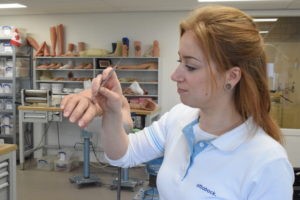A quick introduction: Silicon House “We make lifelike prostheses that allow you to live life to the fullest”
Prostheses come in all shapes and sizes. Nowadays, more and more robotised devices are available, featuring a high-tech and almost futuristic look & feel. But there are still plenty of people who prefer a prosthesis that is virtually indistinguishable from the original body part.
Silicon House is one of the innovation divisions of Ottobock. The brand specialises in the design, development and production of prostheses that can only be distinguished from the "real" limb from close by. How do they achieve this and are these prostheses both cosmetic and functional? Custom Silicone Technician Floortje from Silicon House answers these and other questions.

What is Silicon House?
“At Silicon House, we make lifelike silicone prostheses. In terms of colour, texture and detail, they strongly resemble the original body part. We work with a team of four: Manager Frithjof, Team Leader Evi and Custom Silicon Technicians Susan and myself. We maintain regular dialogue with the specialists at Ottobock. We share knowledge, so that together we can arrive at the highest quality end result and help our customers as best as possible.”
How do people find out about you?
“Silicone prosthesis production is a specialisation that is not common. The process often starts when we are approached by an orthopaedic instrument maker (O&P professional), who usually does not have enough expertise about silicon prostheses to make one personally. So, they contact us. But more and more patients are now contacting us directly after coming across our website or reading about us online. They may be looking for a better solution than the orthopaedic shoe, for example, recommended by the rehab specialist. We help them with a silicon prosthetic foot – a different and sometimes better solution.”
How do you make such a lifelike prosthesis?
“During the first meeting, we take a number of impressions, not only of the residual limb, but also of the limb on the unaffected side. We determine which colours the prosthesis should have, as well as other details, such as birthmarks, freckles, redness and hair. We then make a plaster copy of the impressions, which is used to create the prosthesis prototype. By the way, the prototype is usually not much of a sight: no colour – i.e. completely transparent – and without any detail. But excellent for testing. The patient takes the test prosthesis home and uses it for around two weeks. Where are the pressure points? How does the skin react? Is the prosthesis a good fit? And with a prosthetic foot, does it fit in the shoe? The results of the test phase are used to make the final version. We start from scratch. We combine the silicone with pigment for the colour and add the nails and other details, so that the prosthesis is lifelike.”
Is a silicone prosthesis only cosmetic or is it also functional?
“It is absolutely also functional. A good example is a prosthetic foot. When someone loses all toes or part of a foot, the walking mechanics of the foot are often affected and, in many cases, balance is distorted. The advantage of a prosthetic foot is that it restores this balance and helps with the heel-to-toe gait This kind of prosthetic often means that patients can wear shoes again – even open shoes! With a finger or partial hand prosthesis, the results are comparable. Someone who loses several fingers can also miss, for example, their grip function. A person with a prosthesis can often easily pick things up and, in many cases, regain their grip function. We also add a soft layer in those areas where the bone is close to the skin, thereby reducing pressure. And a prosthesis offers protection. The residual limb is often sensitive because the nerves are confused and close to the surface. A prosthesis helps prevent pain – from blows or wind, for instance. Our silicon prostheses look natural but, most importantly, help lots of people in their daily lives and are comfortable to wear. A win-win situation.
How intensively can you use a silicone prosthesis?
“It’s different for every person. As with other types of prostheses, people also need to get used to a silicone prosthesis, which takes time. So, we recommend not rushing things. Only wear the prosthesis for around an hour on the first day, then two hours on the second day, four hours on the third day, and so on. My best advice is to do what feels right and, if necessary, take it even more slowly. At a certain point, the amputee is able to wear the prosthesis all day long and can shower, cook, run and swim with it. In fact, there are no limits to what can be done with it!”
Can you help everyone who contacts you about a prosthesis?
“Unfortunately, no. We sometimes have to turn people away. With some patients, the amputation is so sensitive that the test phase shows that the residual limb cannot handle any contact. But some patients also have expectations that we are unable to fulfil. Even though a silicone prosthesis is lifelike, they are not getting back their body part. It is up to us to manage expectations. We also lend a listening ear when people want to share their experiences with us. I am more than happy to listen to their story. After all, it’s part of what makes our work so rewarding.”